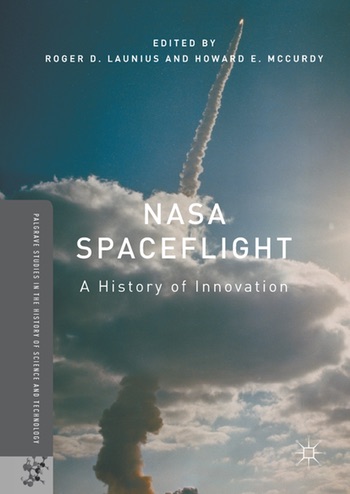Review: NASA Spaceflight: A History of Innovationby Jeff Foust
|
| Not all of the examples included in the book are successful cases of innovation. One essay examined the failed efforts to commercialize the Landsat program in the 1980s, which ended up driving away users. |
Innovation, and partnerships with the private sector, are hardly new to NASA, though. That’s the thesis of NASA Spaceflight: A History of Innovation, a collection of essays edited by Roger Launius and Howard McCurdy on various examples—successful and not—about how NASA worked with companies and other organizations to develop new technologies and capabilities over the years. The book is an insightful, if pricey, look at a wide range of efforts.
The book includes a dozen essays contributed by historians looking at various examples of innovation over the history of the space agency. They range from early cooperation with Britain on the Ariel satellite, setting an example for international cooperation that NASA would follow for decades to come, to NASA’s role in the development of microelectronics in the 1960s, to the more recent examples of partnerships with companies to develop commercial cargo and crew transportation systems.
Not all of the examples included in the book are successful cases of innovation. One essay examined the failed efforts to commercialize the Landsat program in the 1980s, which ended up driving away users and “demonstrates how innovation and commercialization lack linearity and can be a highly political process,” author Brian Jirout argues. Another essay examines the X-33 and X-34 programs of the 1990s, which sought to demonstrate technology for reusable launch vehicles but never flew a single test flight before being cancelled.
In the book’s final chapter, Launius and McCurdy try to use the case studies from the preceding chapters to draw conclusions about innovation. “Although public agencies are not noted for their capacity to innovate,” they conclude, “they are capable of doing so, occasionally alone or more often through arrangements with other bodies.” Innovation is nonlinear and evolutionary, they argue, and difficult to maintain and institutionalize, a lesson they draw from an essay examining the Discovery program of low-cost planetary science missions, which initially adopted a high degree of risk but became more conservative over time.
| Innovation is nonlinear and evolutionary, they argue, and difficult to maintain and institutionalize, a lesson they draw from an essay examining the Discovery program of low-cost planetary science missions. |
The one drawback of NASA Spaceflight: A History of Innovation is its list price of more than $100 (although it is available, in both hardcover and ebook versions, at significant discounts.) That’s a shame since many of the essays are excellent, even when read outside of the context of a larger book on innovation. Paul Ceruzzi, for example, offers a detailed history of microelectronics development in the 1960s and the role NASA played as what would become known as Silicon Valley took shape during the decade. John Logsdon looks at the origins of what might be considered the first “NewSpace” company, Orbital Sciences Corporation, started by three entrepreneurs in 1982 who pooled $1,500 to create a company now on the verge of being acquired by Northrop Grumman for more than $9 billion.
Perhaps, as NASA looks to innovation to find new ways of carrying out existing and proposed missions, book publishing could use a little innovation as well.
